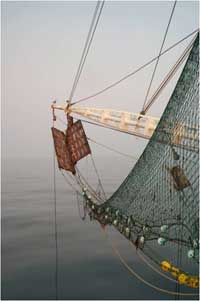Methods - Capture Methods
 The RV Lady Lisa underway, trawling somewhere off the SE USA.
The RV Lady Lisa underway, trawling somewhere off the SE USA.
All in-water research efforts managed by the MRD since the 1970's have relied on the physical capture of sea turtles by bottom trawling. The basic trawl configuration consists of two wooden doors that plane away from each other as the vessel makes headway, which spreads out the trawl net attached to the trailing edge of each door. One set of doors and one trawl net are deployed on each of the port and starboard sides of the trawler/research vessel. For fishery-independent research, paired trawl nets with a headrope length of 60' have generally been used by the MRD. For fisheries observer studies, trawl net sizes ranged from 55' to 90'. Trawl types used in these various studies have included flat nets as well as mongoose nets.

Hoisted trawl gear on the port side of the RV Lady Lisa. The two wooden trawl doors which spread the net under the weight of the water hang just below the outrigger. The large mesh openings of the turtle nets are also evident. Yellow tuna floats (lower right corner) keep the top of the net (aka, the headrope) upright during trawling, while a series of white plastic mud rollers minimize snagging the bottom edge of net (aka, the footrope) on the seafloor.
Since 2000, fishery-independent research conducted by the MRD has relied upon NMFS Turtle Nets which are flat nets with large mesh webbing (4" bar, 8" stretch mesh) to reduce by-catch. Mudrollers, which are documented to minimize damage¹ to sensitive bottom habitats, are also included on the trawl footrope. Because the purpose of research trawling is to capture sea turtles, the NMFS exempts this study from the federal requirement that nets be equipped with a Turtle Excluder Device (TED). However, in order to decrease the probability that research trawling will harm sea turtles², tow times are limited to 30 minute on the seafloor.
At the start of each trawling event, standard meteorological (wind speed and direction, estimated cloud cover, barometric pressure) and hydrographic (sea surface temperature, wave height) observations are recorded. Location and water depth are recorded at the start and end of each trawling event. Vessel towing speed is recorded at the start of the trawl and monitored throughout the trawl transect. Target vessel towing speed is conducted at 2.6 to 3.0 knots to keep the trawl gear from collapsing on itself (at slow speeds) and to tow as fast as possible while still (presumably) maintaining contact between the trawling gear and the seafloor. Approximately 250 daytime trawling events are completed by each research vessel annually during six, multi-day, overnight cruises aboard each of two research vessels: the SCDNR's RV Lady Lisa operated out of Charleston, SC, and the RV Georgia Bulldog operated by the University of Georgia Marine Extension Service in Brunswick, GA.
¹ Van Dolah, R.F., P.H. Wendt, and N. Nicholson. 1987. Effects of a research trawl on a hard-bottom assemblage of sponges and corals. Fisheries Research 5(1):39–54.
² Sasso, C.R., and S.P. Epperly. 2006. Seasonal sea turtle mortality risk from forced submergence in bottom trawls. Fisheries Research 81(1):86–88.
